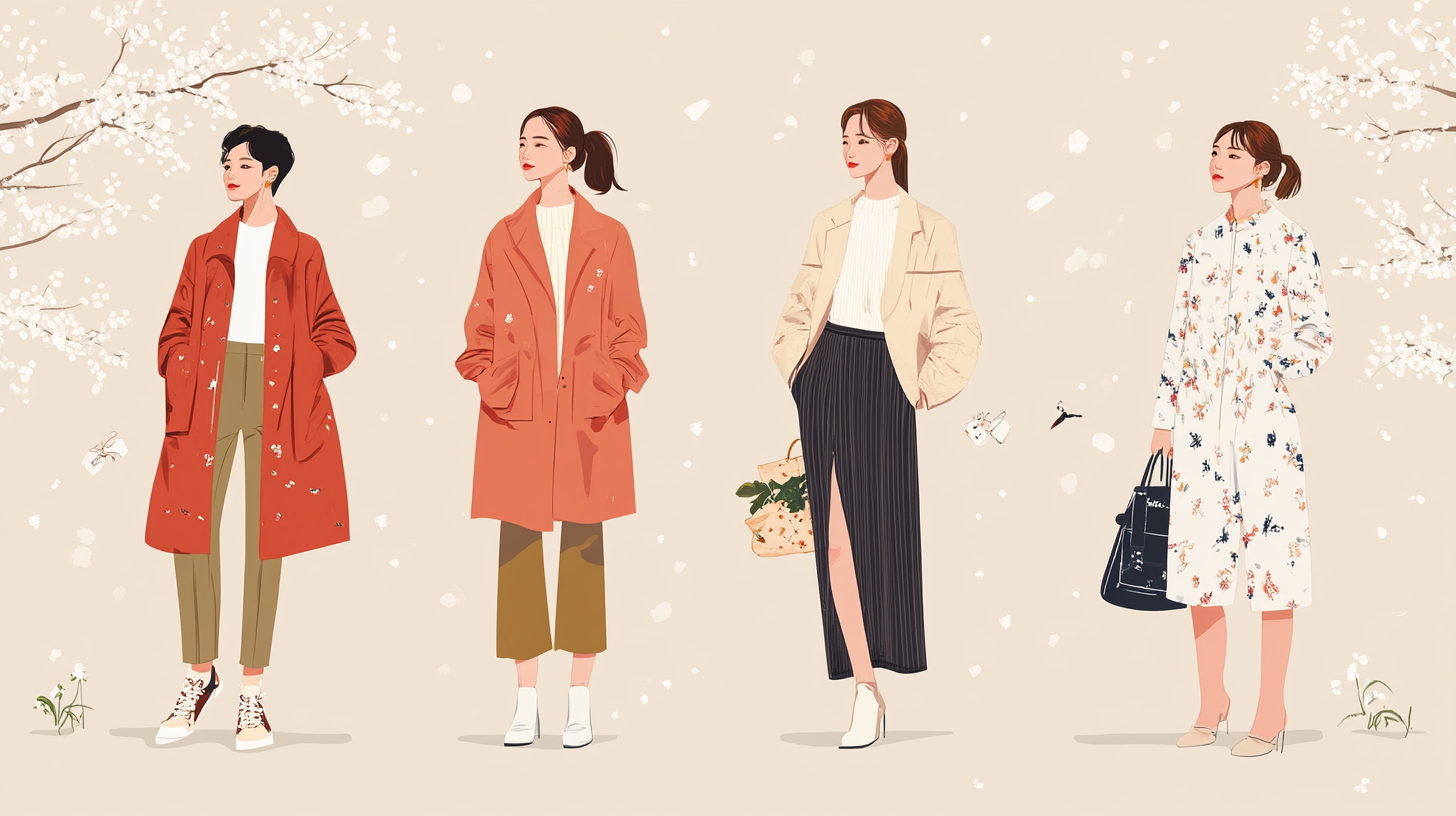1) Understanding Korea’s Four Seasons Weather
Korea experiences a distinct four-season climate, with significant temperature and weather variations throughout the year. Spring, spanning from March to May, is typically warm and dry, making it an ideal season for outdoor activities. Summer, covering June to August, is characterized by high temperatures and humidity, with the monsoon season peaking in July, bringing frequent rain. Autumn lasts from September to November, offering clear, crisp weather, often considered the most comfortable season for activities. Winter, from December to February, can be freezing, especially in northern regions where snowfall is frequent.
Given these dramatic seasonal shifts, adjusting outfits accordingly is essential. Korean four season fashion reflects the climate changes, with layered clothing being a popular choice due to the significant temperature difference between indoor and outdoor environments. Koreans are also keen on matching their outfits to seasonal trends—opting for breathable, light fabrics in summer and wool or padded coats in winter.
2) Spring Fashion Tips: Dealing with Temperature Fluctuations and Fine Dust
Korean spring days are warm, but the temperature can drop significantly in the mornings and evenings. Layering is a practical solution, with lightweight sweaters, cardigans, or thin jackets offering easy adjustability throughout the day. As flowers bloom and the weather brightens, pastel and light-colored outfits become prevalent, reflecting the seasonal mood.
Spring in Korea also brings yellow dust and fine dust pollution, making masks a common accessory. Visitors unfamiliar with air pollution might be surprised, but wearing stylish masks that match outfits or opting for dust-resistant clothing materials can help. Choosing fabrics that don’t attract dust and shaking off clothes after going outside can also help maintain cleanliness.

3) Summer Fashion Tips: Preparing for High Humidity and Monsoon Season
Korea’s summer is hot and humid, with July’s monsoon season bringing persistent rain and sticky conditions. To combat this, breathable fabrics like linen, cotton, and rayon are preferred, along with light-colored outfits that reflect sunlight and help stay cool. While t-shirts, shorts, and summer dresses are popular choices, air-conditioned indoor spaces often require a light cardigan or shirt for extra warmth.
During the monsoon season, waterproof jackets, raincoats, or lightweight windbreakers provide protection from sudden showers. Breathable sandals or slides are ideal for daily wear, but non-slip sneakers or rain boots can be useful for rainy days. While wearing shorts to work remains restricted in many corporate settings, younger companies and startups are gradually embracing a more relaxed dress code.
4) Autumn Fashion Tips: Sophisticated and Stylish for the Crisp Weather
Autumn is considered the best season for fashion in Korea, thanks to its clear skies and refreshing breezes. Popular wardrobe choices include lightweight knits, sweatshirts, trench coats, and leather jackets. Warm tones such as beige, brown, and burgundy dominate seasonal trends. As evenings get cooler, layering or accessorizing with scarves enhances both style and warmth.
This season also sees an increase in weddings and corporate events, making formal or semi-formal attire more relevant. Korean professionals often opt for navy or brown suits, while women choose elegant dresses or tailored pants. Outdoor activities like foliage sightseeing call for trendy casual outfits such as denim jackets, sweatshirts, and sneakers for a stylish yet comfortable look.

5) Winter Fashion Tips: Battling the Cold and Indoor-Outdoor Temperature Differences
Korean winters can be surprisingly harsh, with frequent subzero temperatures requiring thick padded coats or woolen overcoats. Accessories like hats, scarves, and gloves help retain body heat, and in snowy areas, waterproof boots are advisable. Layering is crucial to block out the cold, with thermal innerwear such as HeatTech providing additional warmth beneath outer layers.
Since indoor spaces tend to be well-heated, lighter inner layers are recommended to avoid overheating once inside. A practical winter outfit involves wearing a snug inner layer, a warm knit, and a thick coat that can be removed indoors. While neutral colors like black and gray dominate winter wardrobes, adding pops of red or navy enhances vibrancy.
6) Korean Workplace Dress Code: What to Expect
Korean workplaces exhibit a range of dress codes. Traditional large corporations maintain formal business attire—suits for men with dress shoes, and blouses or dresses for women. Some companies allow “casual Fridays” where more relaxed clothing is acceptable. In contrast, IT firms and startups often welcome jeans, sneakers, and even hoodies.
New employees and expats should observe office norms before settling on an outfit choice. For job interviews or the first day at work, a more formal approach is advisable. Once familiar with an office’s typical dress standards, employees can incorporate personal style within company guidelines. For work-related roles that require frequent movement indoors and outdoors, prioritizing functionality is key.
7) Accessories and Styling Tips
In Korea, accessories play a significant role in completing an outfit. Professionals often carry practical yet stylish bags to accommodate laptops and documents. Sneakers have gained popularity even with office attire, and many opt for comfortable shoes to ease long commuting hours.
When it comes to accessories, men favor wristwatches, while women often add simple jewelry like necklaces or earrings. Excessively flashy accessories may feel overwhelming in conservative workplaces, so starting with subtle items is a safe choice. Changing shoe or bag materials according to the season can also refresh one’s styling.
8) Finding Joy in Seasonal Fashion
Experiencing Korea’s four seasons through fashion is more than just dressing appropriately—it’s a way to embrace everyday joy. Spring brings fresh, light-colored outfits; summer calls for breathable, airy fabrics; autumn encourages layering with warm tones; and winter provides the comfort of cozy coats and sweaters. Adjusting one’s fashion to match the seasons enhances the appreciation of life in Korea.
Ultimately, fashion serves both as a form of self-expression and a practical tool for adapting to the weather. Staying attuned to seasonal changes allows for effortless style while maintaining comfort. By balancing seasonal trends, workplace culture, and personal taste, fashion can transform each day into an exciting new experience.

WeBring Service : Provides personalized services to foreigners living in Korea
Exclusive offer: Introducing foreign car rental in Korea, WeBring-SoCar

